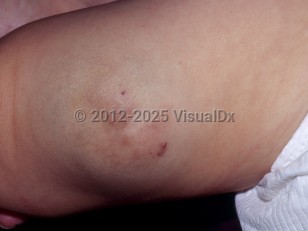Venous malformations (VMs) represent the most common congenital vascular malformations and are estimated to occur in 1-5 of every 10 000 births. They are the third most common congenital vascular lesion to occur in the head / neck region, with infantile hemangiomas and lymphatic malformations being more common.
VMs can involve the skin, subcutaneous tissue, and mucosa. They range in presentation from asymptomatic venous varicosities to exophytic deforming tumors involving the skin, internal organs, and bones, with mass effect on adjacent structures. Visible cutaneous changes may belie much deeper involvement in any given area. VMs can be segmental or localized and may occur in isolation or with other congenital or progressive changes. When additional findings coexist, a vascular overgrowth or venous malformation syndrome may be present. VMs have been associated with CLOVES, capillary malformation-arteriovenous malformation, Maffucci, Klippel-Trenaunay, Parkes-Weber, Sturge-Weber, Gorham-Stout, Bockenheimer, Proteus, and Bannayan-Riley-Ruvalcaba syndromes, as well as familial cerebral venous malformations.
VMs arise from mutations that alter endothelial cell morphogenesis. This leads to disorganized angiogenesis and nonfunctional atypical venous networks. Autosomal dominant inheritance has been reported, but about 95% are presumed to be sporadic. Syndromic forms are more likely to have a defined inheritance pattern. TEK mutations, which are found in blue rubber bleb nevus syndrome, have been identified in 40% of sporadic VMs.
Swelling, pain, and functional impairment, such as limited joint motion, are commonly associated symptoms. Pain may worsen initially with physical activity, but swelling may improve. VMs may be complicated by chronic localized intravascular coagulopathy at any age.
Venous malformation in Adult
See also in: External and Internal EyeAlerts and Notices
Important News & Links
Synopsis

Codes
ICD10CM:
Q27.9 – Congenital malformation of peripheral vascular system, unspecified
SNOMEDCT:
234124003 – Venous malformation
Q27.9 – Congenital malformation of peripheral vascular system, unspecified
SNOMEDCT:
234124003 – Venous malformation
Look For
Subscription Required
Diagnostic Pearls
Subscription Required
Differential Diagnosis & Pitfalls

To perform a comparison, select diagnoses from the classic differential
Subscription Required
Best Tests
Subscription Required
Management Pearls
Subscription Required
Therapy
Subscription Required
References
Subscription Required
Last Reviewed:09/30/2021
Last Updated:03/11/2024
Last Updated:03/11/2024
Venous malformation in Adult
See also in: External and Internal Eye
